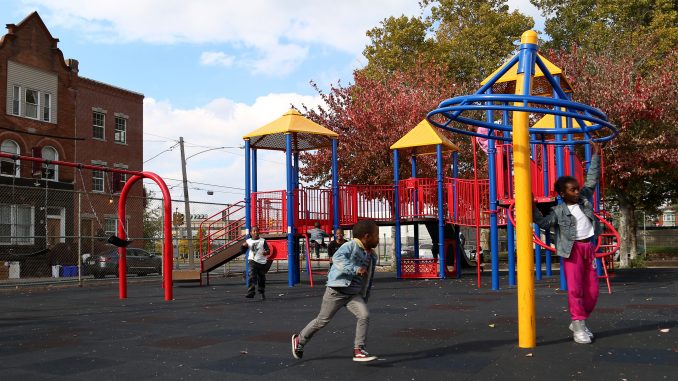
A few times a week, Krima Stevens brings her 2-year-old son and his cousins to the park near where she grew up.
At the Amos Recreation Center, the 25-year-old mother sits and watches her son, Mahni Williams, and the rest of the kids to play, knowing now their time at the park might be limited.
This border between Temple’s campus and the Cecil B. Moore Community, however, might be in jeopardy.
When Stevens learned Temple administration may need the park as a part of its community-altering plans to build a football stadium on Main Campus, she said she had seen it all.
“[Temple] just came in and took over and they don’t care about our viewpoints,” the Willington Street resident said. “They’ve treated us terribly. They don’t involve the community in anything.”
Adjacent to the park, a basketball court frequently hosts a handful of teenagers playing pickup basketball.

Upon finding out about the university’s proposal for the area, one boy looked toward the center of campus, and muttered a question in frustration: “Why here?”
Community members neighboring Geasey Field, a potential location reported by The Inquirer Thursday for the university’s on-campus football stadium proposal, told The Temple News Sunday they haven’t been contacted by university representatives. Some of them don’t mind the prospect of a 35,000-person stadium, but others said it portrayed as the next power move from the university.
“[Residents have] mixed emotions,” said Will Mundy, 71, the block captain of Page Street west of 16th. “Some welcome it, but most of them don’t. … There’s so many issues we have now, the parking and the migration of students to this area in such droves.”
The block currently features a battle for parking between residents and students, and it’s at its height during sporting events at Geasey Field. During a women’s lacrosse scrimmage on Sunday, parents’ cars were parked on the residential street a few blocks away.
Sourcing Temple officials and City Council, the initial report from the Inquirer showed the proposed football stadium layout cutting into the park and basketball courts at the recreation center, but a university spokesman said those figures were not necessarily accurate. The spokesman added that no specifics of the stadium plan are definite, and the plan is still under discussion.
Even if the park is spared by the construction, Stevens said, the community won’t be the same.
“It would be a whole different environment around,” she said. “You can’t expect to just plop something in an environment or an area and just exclude the [people in] the area around. … At some point, there will be some type of altercation or something because you’re not involving the surrounding area.”
The center, accompanied by a basketball court and a swimming pool, has operated as a safe place for children in the area to play.
Stevens is planning on creating a free nutrition class for children in the next year or so.
“This park has been here forever,” Stevens said. “There are kids here, there’s an after-school program here, there’s basketball games here all the time. It gives kids an outlet.”
Michael Thomas, a former resident who was visiting his ex-wife in the area, mirrored Mundy’s thoughts on the influx of properties designated for student housing the Cecil B. Moore Community has seen.
A handful of Temple-affiliated properties now boast realty signs that read “Temple Town.”
“Every once in a while, Temple will snatch up a little bit of land,” Thomas said. “Everything around here is Temple. … The community is angry, they have to go somewhere else.”
Multiple residents said neighbors in the area and other blocks surrounding campus struggle to tolerate the noise of loud parties on special occasions, but also with noisy early-morning practices from the marching band.
“There was a party in this area with over 100 students in August,” Mundy said. “I’ve been told that the problem is students from other colleges, but they come here to party. … Various sororities and fraternities have their affairs—they should be somewhere else.”
Several community members expressed displeasure with student nightlife in their area, with complaints ranging from empty beer bottles strewn on their properties, to drunk students mistakenly stumbling into their homes late at night.
“Drunk [students] walk in our house all of the time,” Stevens said. “So bringing a stadium here where they are going to have pep rallies and all of the games … it’s certainly not going to make the area better.”
For Stevens, the expected stadium construction is a missed opportunity for the university to communicate with its neighbors.
“It’s just not fair.”
E.J. Smith can be reached at esmith@temple.edu or on Twitter @ejsmitty17.
Jenny Kerrigan contributed reporting.


Be the first to comment